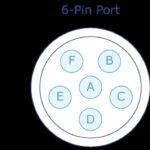Understanding the On-Board Diagnostics II (OBD2) protocol is crucial for anyone looking to diagnose and maintain modern vehicles, especially Dodge models. This guide delves into the specifics of the Dodge Obd2 Protocol, drawing upon service manual information to provide a clearer picture of connector pinouts, communication nuances, and potential troubleshooting steps.
Understanding Dodge OBD2 Connector Pinouts
Navigating the intricacies of the Dodge OBD2 system begins with understanding the data link connector and its relationship to the Powertrain Control Module (PCM). Service manuals provide valuable insights into these connections, outlining the specific functions assigned to each pin.
Initial information from a service manual highlights the following connections between the data link connector and the PCM connector:
- PCM Connector (C1) – Data Link Connector – Function:
- C1-38 – PCI BUS 7
- C1-36 – SCI Transmit (PCM) 12
- C1-25 – SCI Receive (PCM) 15
- C1-37 – SCI Transmit (TCM) 9 (Note: TCM – Transmission Control Module – Not Applicable to SRT-4 or PT MTX)
- Cluster C1-25 – FLASH Prog Enable 16
- B+ (Battery) 2
- ABS Controller 5 – PCI BUS 4&5
- Ground
Further examination of a PT Cruiser Manual (8W-18-3 BUS COMMUNICATIONS) provides a slightly different perspective on the DATA CONNECTOR – White 16 Way pinout:
- DATA CONNECTOR – White 16 Way:
- 2 – PCI BUS 4&5 – GROUND
- 7 – SCI TRANSMIT (PCM)
- 9 – FLASH PROGRAM ENABLE
- 12 – SCI RECEIVE (PCM)
- 16 – FUSED B+
Based on this information, a likely configuration for basic OBD2 communication in Dodge vehicles involves:
- Pin 7 (SCI Transmit): For transmitting data from the PCM.
- Pin 12 (SCI Receive): For receiving data by the PCM.
- Pin 4 or 5 (Ground): For establishing a ground connection.
These pins are crucial for establishing communication with the vehicle’s computer system using OBD2 scan tools.
Communication Protocols: SCI and PCI Bus
The pinout descriptions mention SCI (Serial Communication Interface) and PCI (Peripheral Component Interconnect) BUS. These are communication protocols used within the vehicle’s network.
- SCI (Serial Communication Interface): A common protocol for serial data exchange, likely used for PCM communication in this context. The SCI Transmit and Receive pins facilitate this communication.
- PCI BUS: A higher-speed communication bus used for various modules within the vehicle. The presence of PCI BUS connections in the pinout suggests its involvement in the broader diagnostic and communication network of the Dodge vehicle.
While the exact protocol might be J1850, as speculated in some contexts, the service manual information points towards SCI and PCI BUS utilization for OBD2 communication in these Dodge models. It’s important to note that automotive communication protocols can vary across different models and years.
Navigating OBD2 Diagnostics and Potential Challenges
The evolution of OBD standards, from OBDII to OBDIII and beyond, introduces potential complexities. While the PCM in certain Dodge upgrades and newer models might be described as OBDIII compliant, it’s essential to understand that scan tool compatibility is key. The mention of OBDIII scan tools being “OBDII/EURO Stage III compliant” suggests a gradual evolution and potential overlap in standards.
One significant point raised is the change in the data connector around mid-year 2002, which might explain compatibility issues with certain aftermarket tools for later models. This highlights the importance of verifying compatibility and potentially using adapters or protocol translators when working with different Dodge models and scan tools.
For basic communication using the identified pins (7, 12, and ground), a simple setup might involve a MAX232 level translator IC. This IC can convert the TTL level signals from the PCM to RS-232 levels suitable for serial output, offering a basic communication pathway. For enhanced isolation and protection, incorporating an opto-isolator before the MAX232 circuit is a recommended improvement.
Accessing Comprehensive Information
The original text rightly points out the challenge of gathering complete and coherent information about automotive diagnostic systems. Service manuals, while comprehensive, often spread crucial wiring and communication details across thousands of pages, making it difficult to get a holistic view. This fragmented information landscape can be frustrating for those seeking to understand and work with these systems.
The sentiment that manufacturers might intentionally make it difficult for independent tuners or mechanics to access detailed system information is also a common observation within the automotive aftermarket.
Conclusion: Leveraging Service Manuals and Careful Testing
Decoding the Dodge OBD2 protocol requires careful attention to service manual information and a methodical approach to testing and diagnostics. Understanding the pinouts, communication protocols like SCI and PCI BUS, and potential compatibility issues arising from evolving OBD standards are crucial steps. While challenges exist in accessing and consolidating all necessary information, resources like service manuals and practical experimentation remain invaluable for navigating the complexities of Dodge OBD2 systems. When in doubt, always refer to the specific service manual for your Dodge model year to ensure accuracy and avoid potential system damage.
